History and culture of Pakistan – Paper 1 Pakistan Studies 2059 A Quick revision document to be used in conjunction with Nigel Kelly's book PDF

| Title | History and culture of Pakistan – Paper 1 Pakistan Studies 2059 A Quick revision document to be used in conjunction with Nigel Kelly's book |
|---|---|
| Author | Fahad Arshad |
| Pages | 42 |
| File Size | 937.5 KB |
| File Type | |
| Total Downloads | 2 |
| Total Views | 333 |
Summary
History and culture of Pakistan – Paper 1 Pakistan Studies 2059 A Quick revision document to be used in conjunction with Nigel Kelly’s book. SOT Zaidi 1 Mughal Period Date Event 1707 Death of Aurangzeb 1707 Death of Aurangzeb 1738-9 Persian Invasion under Nadir Shah 1761 Marathan Army destroyed in t...
Description
History and culture of Pakistan – Paper 1
Pakistan Studies 2059 A Quick revision document to be used in conjunction with Nigel Kelly’s book. SOT Zaidi
1
Mughal Period Date
1707 1707 1738-9 1761
Event
Death of Aurangzeb Death of Aurangzeb Persian Invasion under Nadir Shah Marathan Army destroyed in the 3rd battle of Paniput British Expansion and Sir Syed Ahmed Khan.
Date
1612 1757 1773 1778-82 1780-84 1784 1800 1839-41 1843 1845 1848-49 1853 1857 1858 1862 1873 1875 1857 1885 1900
Event
First British post at Surat. Battle of Plessey. Regulating Act passed to make EIC accountable to British parliament. British War against Marathas. British wages war over Haider Ali of Mysore India Act give authority to British Government over EIC and Indian Issues. EIC prohibits export of India Cloth to Britain. Capture over Afghanistan and the great massacre by Afghanis on British. British Annexes Sindh. First Sikh War. Second Sikh War. First public journey by train in India happens. War of Independence. British takes Direct control over India. End of EIC role in India. Sir Syed Ahmed Khan sets up the Scientific Society EIC is wound away. Sir Syed Ahmed founds the college at Aligarh Sir Syed Ahmed knighted by British. Indian National Congress set up. Hindi granted equal status to Urdu.
Quick Revision Guide
SOTZ PUBLICATIONS©
Page 1
2
The Pakistan Movement 1899 1905 1906 1909 1911 1913 1914-18 1916 1917-21 1918 1919 1920-22 1922 1923-24 1923 1927 1928 1929 1930 1931 1932 1933 1935 1937 1939 1940 1941 1942 1944 1945 1946 1947
Lord Curzon appointed as Viceroy Parttion of Bengal; Swadeshi Movement by Hindus Hindus demand self government; All India Muslim League is set up. Jinnah becomes an Active Congress member. Morley Minto Reforms; Indian Council Act. Partition of Bengal reversed. Muslim League demands Self Government. World War 1 Lucknow Pact Lord Chelmsford is declared as the new viceroy. Mont Ford Reforms. Rowlatt Act- Imprisonment without Trial. Amritsar Massacre Government of India Act Khilafat and Ghandi’s Non-cooperation Movement. Hijrat Movement Chora Chori Incident. Turkey becomes Republic; Attaturk Abolishes Caliphate. Jinnah joins Swaraj Party Simon Comission Set up Nehru Report. Jinnah gives his 14 points. 1rst Round Table Conference. Allama Iqbal Allahabad Address 2nd RTC 3rd RTC Chuadhri rehmat Ali publishes “Now or Never” India Act 1935 passed Elections take place, Congress wins the Election. Congress Ministries resigned; Day of Deliveance celebrated. Lahore Resolution; August Offer Atlantic Charter Cripps Mission; Quit India Movement Gandhi Jinnah Talks Simla Conference; End of World War 2 Cabinet Mission Plan. Direct Action Day; Calcutta Riotts. 3 June Plan Pakistan and India achieve Independence.
Quick Revision Guide
SOTZ PUBLICATIONS©
Page 2
3
The New Nation 1947 1948 1949 1951 1955 1956 1958 1959 1960 1962 1965 1966 1967 1969 1970 1966 1971 1972 1973 1974 1977 1979 1979 1988
Pakistan Achieves Independence; Kashmir Issue begins; Liaquat Ali Khan as Prime Minister. Death of Quid-e-Azam; Water Dispute with India; Ceasefire on Kashmir Issue. Liaquat Ali Khan Assassinated. Khwaja Nazimuddin One Unit Policy by Iskandar Mirza.; Parliamentary Government Restored First Constitution of Pakistan; Pakistan becomes an Islamic Republic. Ayub Khan takes power; martial law regimes. Basic Democracies takes hold. Ayub Khan becomes President; Government moves to Islamabad The new constitution. Ayub Khan wins presidential election against Fatima Jinnah. Bhutto resigns from Ayub Khan’s Government New Capital Officially Completed and Declared; PPP formed. Ayub Khan again declares Martial Law. Elections; Awami League wins in East Pakistan; PPP wins in West Pak. 6 point Programme War begins against Bangladesh. Bangladesh separates. Simla Accord signed. Bhutto’s Constitution. Islamic Summit. Bhutto calls the elections; Bhutto charged with conspiracy to murder. General Zia seizes power. Hudood Ordinance introduced. Bhutto Hanged in Rawalpindi. USSR invades over Afghanistan. Zia agrees with US to help Afghanistan USSR troops withdraw. General Zia die’s in a plane crash.
Quick Revision Guide
SOTZ PUBLICATIONS©
Page 3
4
Pakistan’s international relations India 1948-49 1950 1965 1971 1972 1987 1988-89 1989 1999-2007 2007-11
Kahmir Issue and ceasefire. India stops Pakistan’s Water supply. Agreement over Bengal and Assam border. Liaquat Nehru Pact for the minorities in both countries. Indian Pakistan War Another War. Bangladesh separated Simla Accord Threat of War from India. Good relations with the democratic set up. Kargal Issue; Relations deteriorate. Good relations in Musharaf Government. Very Good relations with the Zardari Government.
Relations with AFGHANISTAN 1947 1955 1966 1965-71 1974 1979-88 1988-92 1992 1993-99 2000-01 2008-11
Unfriendly relations due to border dispute of Wakhan Strip. Afghanistan opposes Pakistan’s membership in UNO. Relations further deteriorate due to Afghanis attacking on Kabul Embassy Iskandar Mirza visits Afghanistan to normalize the relations Afghanistan did not support Pakistan in Wars against India but was neutral. ZAQ visits Afghanistan.. Good relations because of Pakistan aid against Russian invasion and Ceasefire. Civil War Breaks in Afghanistan and Pakistan helps in formation of Mujahiddin Government. Vry good relations with Mullah Omar Government. Good relations with Mujahidin Government. Relations deteriorated due to Musharaf’s American Support on 9/11 incident. Better relations than Musharaf’s government and many pacts have been signed.
Quick Revision Guide
SOTZ PUBLICATIONS©
Page 4
5
Pakistan Relation with Iran Very good relation since ancient times due to Ottoman Empire and Islamic Bond. 1947 1949 1955 1964 1965-71 1972-73 1979 1985 1985-88 1988 1998-99 1999-07
Iran is the first to Acknowledge Pakistan’s existence. Pakistans PM visits Iran. Iran and Iraq join Pakistan in Baghdad Pact. Both countries join In RCD (Regional COOPERATION Development.) Iran supports Pakistan in the Wars. ZAQ’s Government and relations remained good. Iranian Revolution and Pakistan supported it, trying to establish good with the new government. RCD restructured and was made more effective. Good relations under G. Zia. Benazir Government. Very Good Relations. Good relations Not veryu good relations due to nucleur Issue and American pressure on Pakistan to turn against Iran.
Pakistan Relations with China. 1949 1952 1959 1960’s 1961-62 1962 1963 1965-71 1964 1978 1986 1993-2000 2000-07
China becomes Independent. Diplomatic relations between the countries begin. Pakistan supports China to get UNO membership. China voted against China Admission to UN and condemned the military action in Tibet. A $60 Million long Term interest free loan regarding import of machinery. China applied for permanent membership of Security Council. Pakistan supported this act. Pakistan support to China in China-India War. Boudary Agreement in 1963. China allows PIA to use Chinese air ports and provided loans. China supports Pakistan in the wars against India. Good relations. Prime ministers meet. Karrakoram Highway for better trade established. Civil treaty nuclear cooperation. Pakistan fully supports religious movement in China. Good Relations with Musharaf Government, many trieties signed.
Quick Revision Guide
SOTZ PUBLICATIONS©
Page 5
6
Pakistan and USA. 1947 1950 1955 1956 1962 1965 and 71 1972-74 1977-79 1979-89 1989-99 1998-99 2000-08 2008-11
Pakistan joins UNO and becomes Pro American Country. PM Liaquat Ali visits United States. SEATO and CENTO signed for military and economic aid given. For Defence. Pakistan supports USA spy Mission. U2 issue weakened relations. Relations Strained because US was aiding India in war against China. Pakistan was not provided with military aid. It left CETO and CENTO Not good relations with Bhutto government and Nuclear Issue. Zia was not supported and relations remained bad. Aid was suspended. Very good relations because Zia’s favour and help against USSR invasion in Afghanistan. Not very good relations with the democratic government. Bad relations because of Nuclear bomb testing by Pakistan. Very good relations with Musharaf government. Very Good relations.
Pakistan and the United Nations 1947 1948 1965 1971 1978 1988 2001
Pakistan get UN membership. UNHCR aids in solving refugee problem. UN passes resolution on Kashmir Issue. UN plays its role in ceasefire over Kashmir. Canal Water Dispute, UN helps to solve it. UN again plays its role over ceaze fire over Kashmir War and arranged the Tashkan Agreement. Indian invasion and separation of Bengal; UNO failed and relations with Pakistan disrupted. Russian invasion- UNO aided Pakistan to stop Russian invasion in Afghanistan. Russian War ends and Pakistan is appointed to arrange Juneva Agreement. 9/11 Incident; American invasion over Afghanistan, UNO supported Pakistan in support for USA
Quick Revision Guide
SOTZ PUBLICATIONS©
Page 6
7
Pakistan Relation with Common Wealth countries Pakistan s initial relations were difficult due to the reluctance of British to accept Pakistan and the injustice of Boundary Comission. On the other hand Pakistan needed Britain and its senior officials for training of Army and official workers. Throughout the first 40 years of its emergence Pakistan has stayed on good terms with Brirtain. 1956
1960 1965 1971 1980’s 1989 1979-88
Pakistan declares itself republic by making its own constitution. Until now it had been under the British Crown. Relations deteriorated because Pakistan criticized Britain over the invasion of Suez Canal Relations improved as many Pakistani’s went to Britain due to the construction of Tarbela and Mangla Dam. Britain played a major role in ending the war between India and Pakistan. Britain recognized Bangladesh as separate country against the will of Pakistan and so Pakistan left Common Wealth in protest. Britain remained a strong ally and trading Partner. Relations improved because Pak. Returned to Common Wealth. British supported Pakistan and aided in Afghan Crisis.
Relations with Bangladesh 1971 1974 1974 1975 1985 and 88
Very bitter relation. Pakistan stated to break bonds with any country ready to recognize Bangla as a separate country. Pakistan invited Shiekh Mujib on the Islamic Summit Conference. Both countries agreed to try having friendly relations. Bhutto visits Bangladesh and division of Assets was discussed. Shiekh Mujib died and the new leader tried to improve the relations further but refused to withdraw claim over assets. Bangladesh hit by severe storm, Pakistan was the first country to contribute for them.
Quick Revision Guide
SOTZ PUBLICATIONS©
Page 7
8
Pakistan and USSR 1947 1949 19501954 1954 1956 1960 1961 1963 1965 1968 1972 1978-88 1989-1999 200-2007
Pakistan joined UNO, Russia was not happy. Visit of Liaquat Ali to USA rather than USA harms initial relations. Russia began to support India over Kashmir Issue. Joining SEATO with USA widened the gulf. Pakistan joined Anti-Communist Pact which angered Russia. Rejecting Aid from USSR harmed relations. Pakistan Accepted Soviet assistance in search of Water and mineral. U2 Crises harmed the relations. Soviet Oil Exploration in Pakistan. Pakistan receives Pound 11 Million loan. Improvement in relation because Pakistan left SEATO and CENTO. Visit of Ayub Khan. Soviet Arms supplied to Pakistan. ZAB’s gov. tried to improve relations by signing agreement to built Steel Mill in Pakistan and visiting USSR. Bad relations because of Russian Invasion over Afghanistan. Better relations with the 4 democratic gov. Bad relations because of Pakistan’s support for America over the War of Terrorism.
Quick Revision Guide
SOTZ PUBLICATIONS©
Page 8
9
Struggle for Cultural Identity (The First 3 are described in a very detailed points in the book) Titu Mir Biography: 1. Was a disciple of Syed Ahmed Shaheed. 2. His real name was Mir Mirthar Ali. 3. He was from West Bengal. 4. He was a man of Action like his teacher. 5. Killed in 1831. Beliefs: He was a man of action. He believed in the practicality of life. He did not like the rule and cruelty of British and Hindu Landlords. It was his belief to stand against the Oppressors Rule.
Work: He provoked the British and gave confidance to Muslims to stand against the cruelty to protect their identity. He attacked Hindu Landlords and defeated them boldly. He made village of Nalkerbaria, his head quarters and gathered a small army. He constructed a Bamboo Fort for his army to stay. Importance: He provoked fear In hearts of British and zamindars. He gathered a small army. He inspired Muslims to take defence for their religion and identity. Quick Revision Guide
SOTZ PUBLICATIONS©
Page 9
10
The British Arrival and Expantion Introduction: Some of the British Merchant’s sought permission from the Queen Elizabeth 1 to trade with India and started their trade in 1612. Their first post had been established at Surat in 1908. Slowly the influence grew. In 1664, trading post established in Bombay. 1690 post in Calcutta. By end of the 17th Century, EIC was thinking how to lay a permanent British Hold over India.
Expantionism: The rule of 3. British used Divide and rule policy to rule and capture India. They used further 3 methods to capture over India: 1. Direct Wars: fought with Hyder Ali and Tipu Sulatn of Mysore notably. Also with Nawab Siraj and Mir Qasim. 2. Subsidiary Alliances: These were the alliances made with local princes. According to the terms, the real matters of the land were given in hand of British in return of British protection and money. Furthermore the ruler could stay on throne though only as a British puppet. In this British was able to reinforce its control over India. 3. Doctrine of Lapse: The law stating that all rulers under the terms of subsidiary alliances if do not have any natural male heir then after their death the land will belong to British. One of the affected was Rani of Jhansi who later played an important role in the War of Independence 1857. Battle of Plessey: The French encouraged the Nawab of Bengal to attack the EIC base at Calcutta. Further more the Fortification of British post on Calcutta was also against agreement with the Nawab of Bengal and so Siraj-ud-Daulah marched over Calcutta and seized Fort William and locked the British residents in a small room. 23 out of 65 people died and so Battle of Plessey began. Robert Clive succeeded in defeating Siraj by bribing one of his key men Mir Jaffer. Jafar was made the new Nawab of Bengal and Bengal came under EIC’s rule.
Quick Revision Guide
SOTZ PUBLICATIONS©
Page 10
11
Assault on Afghanistan: The British were threatened about Russia seeking to expand its terrirory. In 1939, Briitsh invaded Afghanistan and installed its own puppet ruler, however the British army could not face the difficult terrain of Afghanistan as well as the locals and soon within Two years the Afghan’s rebelled and massacred the British force. Out of 4000 soldiers, only one doctor from Kabul survived and reported the incident. The Annexation of Sindh: In 1843 The British pride was hurt by the invasion in Afghanistan and decided to attack on Sindh under Sir Charles Napier to restore their Pride among Muslims and to capture the important Route through Bolan pass. Even in Britain many people condemned Napier’s action for they had broken a friendship treaty with the Amirs of Sindh. The Capture of Punjab: The British now turned to Punjab threatened by the increasing power of Ranjit Singh and now to capture the trade route over Indus River and Khyber Pass. The Sikhs were worried also and so they attacked on British controlled India in 1845, First Sikh War. Their main army was destroyed. Finally in 1848-9 Second Sikh War, the Sikh army was destroyed and so the British took over Punjab. The NWFP also came under British rule with Capture of Punjab.
Quick Revision Guide
SOTZ PUBLICATIONS©
Page 11
12
Pakistan Movement The Partition of Bengal, 1906- Bengal was partitioned due to some very important reasons. 1. Bengal was a very large province geographically and population wise. It was an area with a population of 54 million (42million Hindus and 12 million Muslims) in East Bengal alone and 31 million in West Bengal. 2. It was the demand of Muslims for they wanted a separate province in their rule where they would have more favour and better jobs. So to make Muslims happy. 3. They wanted to cut the power of Indian National Congress which had started speaking against British agitating people. Further many terrorist agencies had sprouted up, so to tackle them it was a necessary step for British.
Reaction of Muslims: Muslims were happy as there demand had been approved. Muslims, who had been denied of education and many other facilities while Hindus prospered, had their positions improved overnight. Muslims were happy as they had recognition now. They were now able to escape from Hindu oppression. They had a place where they could protect their religion, values and identity. They felt a feeling of loyalty for the British. Hindu Reaction: Hindu were very angry and they started non cooperation campaign. They blamed British of dividing them with their Divide and Rule policy. They claimed that British had tried to weaken Hindu Unity because they had started to call for reforms through the use of Congress. Hindus performed many protests and many petitions were sent to the government. They attempted assassination over the new viceroy Lord Minto due to this event. They started a Swadeshi Movement in which they stopped buying British goods and threw many British goods in fire. British sales dropped dramatically. Simla Deputation and Formation of Muslim League: Muslims watched Hindus reaction on partition of Bengal and decided something had to be done to protect their identity. Further more National Congress was dominated by Hindus and Muslims needed a base of their own as their voice for the British for Hindus could not be trusted to favour Muslims. Quick Revision Guide
SOTZ PUBLICATIONS©
Page 12
13
They wanted to stand up and have some rights. They needed to get some reforms. They wanted right of separate electorate to protect their interests, religion and language. Thus they formed they had a meeting with Viceroy Minto in Simla on 8th October 1906. Simla Deputation: Asked for separate electorates. They asked for higher percentage of seats than their higher population. Morley Minto Reforms, 1909: Also known as the Indian Council Acts. Basically it increased representation of Hindus and Muslims in different councils. Reversal of Partition of Bengal and its effect: Because new viceroy and King George 5 ordered for the reversal of partition. British had been forced to reverse by Hindu protests. The British feared more assassination attempts from Hindus. It affected the Muslims greatly whose feelings of loyalty had been taken for granted and they realized that they need to be organized to have a voice of their own. The Lucknow Pact, 1916: Was the first Agreement between Congress and Muslim League. Important as it established Jinnah as the focal point for this agreement and showed his great political abilities. It was done because the Muslim League felt that they needed the support of Congress in its early years. Because they thought they could pressuri...
Similar Free PDFs
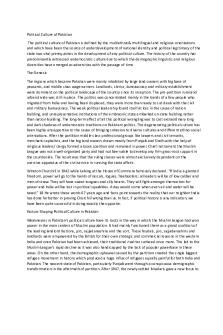
Political culture of Pakistan
- 11 Pages
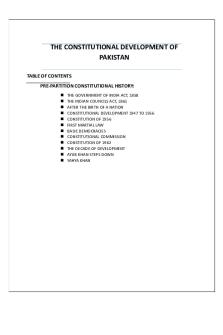
Constitutional History of pakistan
- 16 Pages
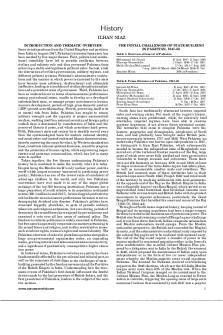
History Of Pakistan 1947-2017
- 15 Pages

Assignment 4 Pakistan studies
- 4 Pages

History (Of Pakistan, 1947-2019)
- 16 Pages
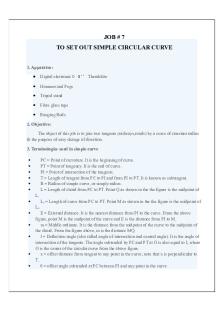
JOB - pakistan history flowchart
- 5 Pages

Gratuity Law in Pakistan
- 4 Pages

Failure OF Democracy IN Pakistan
- 4 Pages

Pakistan Studies - Lecture notes 1-30
- 126 Pages

Energy Crisis in Pakistan
- 11 Pages

Pakistan History by M.R Kazmi
- 69 Pages
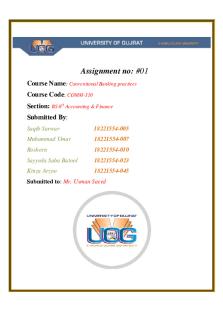
25 Banks of PAKISTAN
- 25 Pages
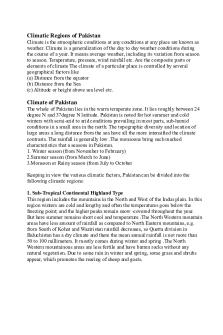
Climatic Regions of Pakistan
- 2 Pages
Popular Institutions
- Tinajero National High School - Annex
- Politeknik Caltex Riau
- Yokohama City University
- SGT University
- University of Al-Qadisiyah
- Divine Word College of Vigan
- Techniek College Rotterdam
- Universidade de Santiago
- Universiti Teknologi MARA Cawangan Johor Kampus Pasir Gudang
- Poltekkes Kemenkes Yogyakarta
- Baguio City National High School
- Colegio san marcos
- preparatoria uno
- Centro de Bachillerato Tecnológico Industrial y de Servicios No. 107
- Dalian Maritime University
- Quang Trung Secondary School
- Colegio Tecnológico en Informática
- Corporación Regional de Educación Superior
- Grupo CEDVA
- Dar Al Uloom University
- Centro de Estudios Preuniversitarios de la Universidad Nacional de Ingeniería
- 上智大学
- Aakash International School, Nuna Majara
- San Felipe Neri Catholic School
- Kang Chiao International School - New Taipei City
- Misamis Occidental National High School
- Institución Educativa Escuela Normal Juan Ladrilleros
- Kolehiyo ng Pantukan
- Batanes State College
- Instituto Continental
- Sekolah Menengah Kejuruan Kesehatan Kaltara (Tarakan)
- Colegio de La Inmaculada Concepcion - Cebu


